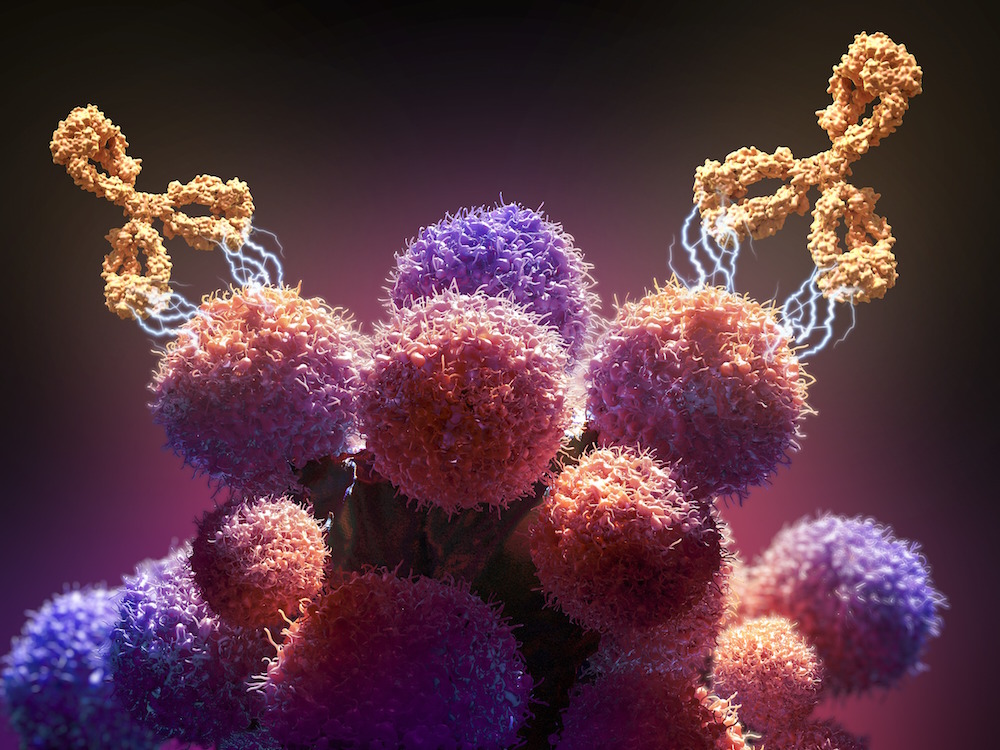Monoclonal antibody therapy is a kind of immunotherapy that empowers the body’s immune system to attack cancer cells.
Our body produces billions of different kinds of antibodies, which are part of the immune system. They have specific archnemeses in the immune system that they target, such as pathogens like diseased cells or viruses. Monoclonal antibodies used in cancer treatment are designed in a lab to target certain antigens — foreign substances in the body — that live on the surface of cancer cells. By targeting those antigens, the antibodies are able to latch onto the cancer cells and act as a “call to arms” for other disease-fighting warriors in the immune system.
More than a dozen monoclonal antibodies have been approved by the Food and Drug Administration (FDA) to fight different types of cancer, including breast, head and neck, lung, liver, bladder, and melanoma skin cancers, as well as Hodgkin lymphoma. First tried in advanced melanoma, monoclonal antibodies have extended some patients’ survival as much as 10 years.

Naked monoclonal antibodies
“Naked” monoclonal antibodies, or monoclonal antibodies that work by themselves, are the most common kind of monoclonal antibody used to treat cancer. Like all monoclonal antibodies, they bind to specific proteins on cancer cells and rally immune cells to their cause. One way they do this is by targeting immune system “checkpoints,” regulators of the immune system.
Cancer has evolved to become smart enough to develop an array of escape mechanisms to trick the immune system into ignoring it as a threat. This includes impersonating normal body cells and exploiting checkpoint proteins such as PD-1 on T cells in the immune system.
T cells seek out and destroy foreign invaders and cancerous cells, but PD-1 helps rein in the T cells so that they don’t go overboard and destroy healthy cells. However, many cancer cells wear a protein called PD-L1, which can fool T cells into treating them as normal cells, leaving them to multiply freely. That’s where naked monoclonal antibodies come in: They can block these checkpoint molecules, allowing T cells to seek out and destroy the cancer cells.
Naked monoclonal antibodies can also work by latching onto antigens on cancer cells that help cancer cells proliferate. An example of this is trastuzumab (Herceptin), which is used to target the HER2 protein, which is sometimes found on the surface of breast and stomach cells.
Conjugated monoclonal antibodies
Other monoclonal antibodies carry a radioactive substance, drug, or toxin that kills cancer cells recognized by the antibody. These are called conjugated monoclonal antibodies.
Antibody-drug conjugates, antibodies that have chemotherapy drugs attached to them, target the surface of cancer cells and deliver the toxic substance to that specific area. This approach can eliminate some of the side effects of chemotherapy, which can damage healthy cells when used as a single agent.
Radioimmunotherapy is a treatment that uses monoclonal antibodies in combination with radiation. By attaching a monoclonal antibody to a radioactive molecule, this technique can deliver a dose of radiation therapy directly to tumor cells.
Side effects
Monoclonal antibody therapy can result in side effects for patients, particularly when used in combination with other treatments. Those side effects can include fever, chills, weakness, headache, nausea, vomiting, diarrhea, low blood pressure, and rashes.
Discuss your cancer treatment options with your doctor, who can help you decide whether monoclonal antibody therapy is right for you.
